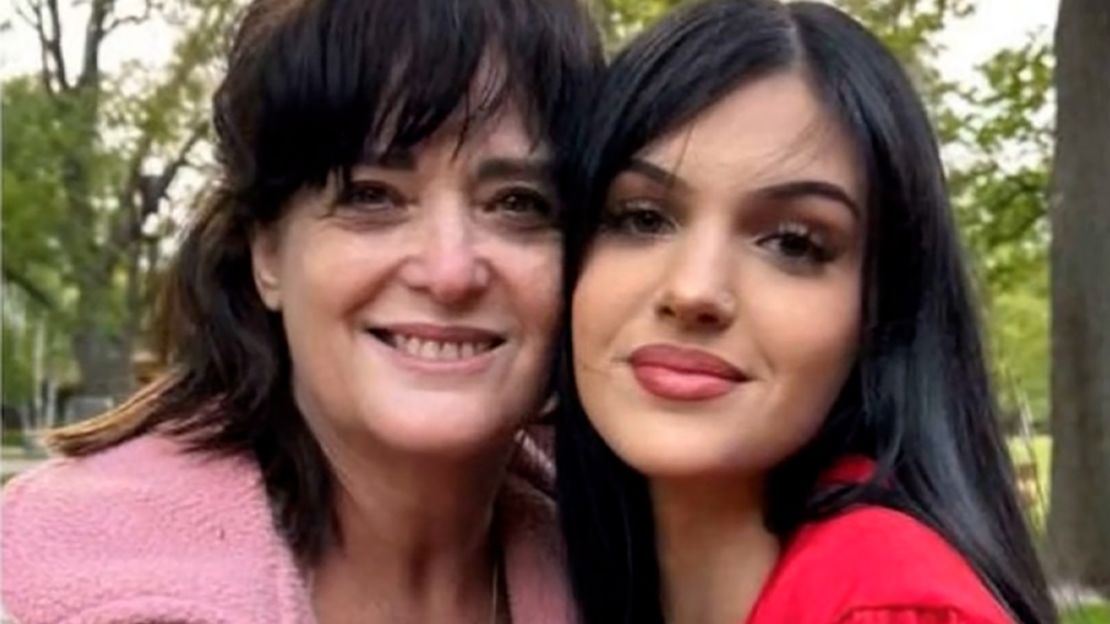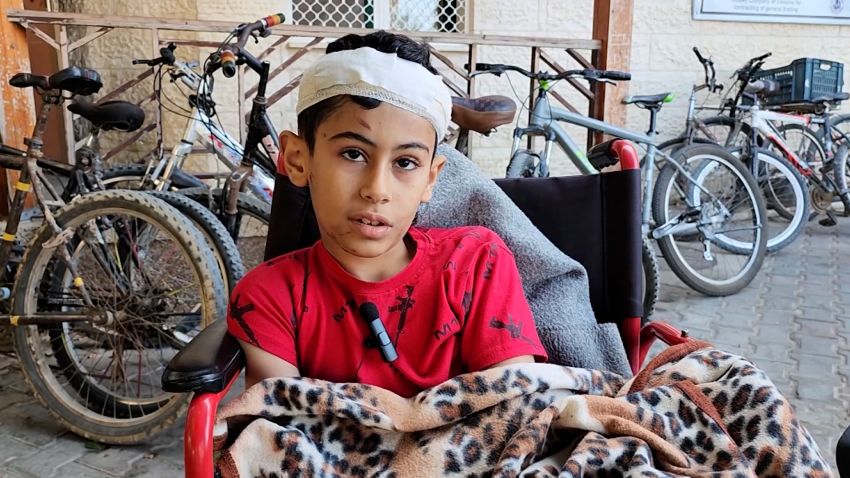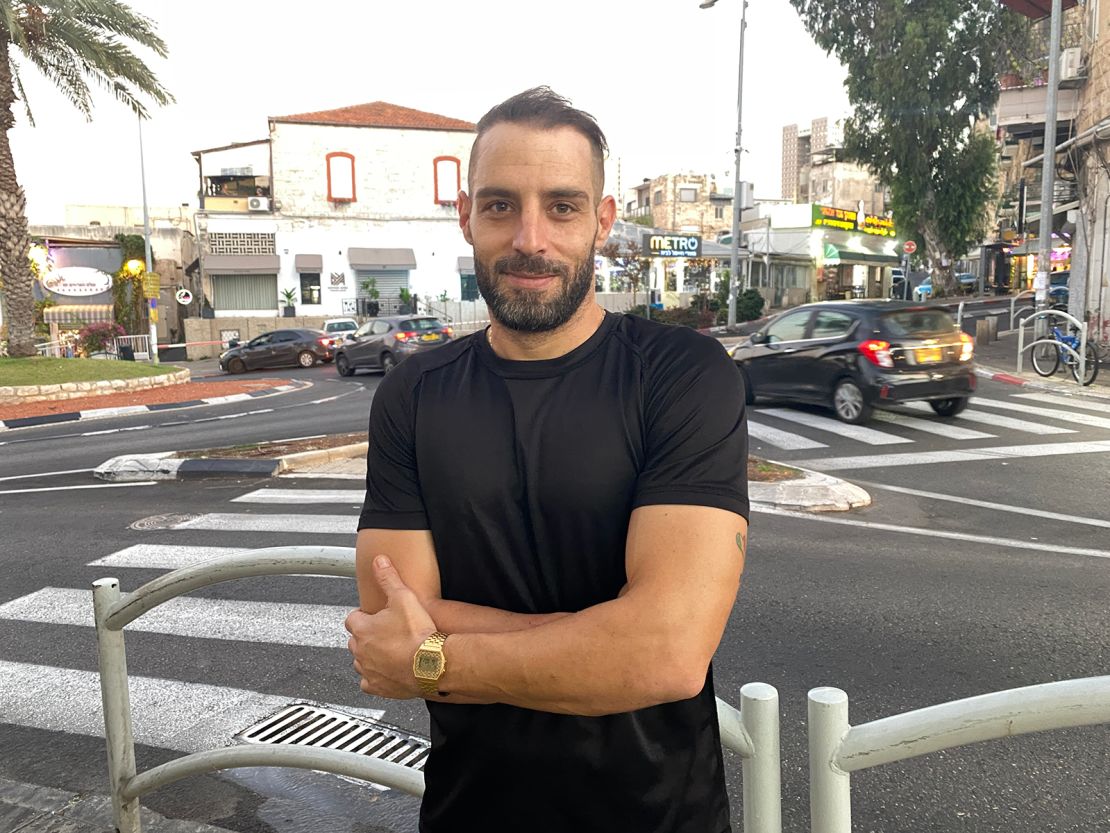The Israeli military chief has told commanders that the military will “enter the Gaza Strip” and initiate an operation to take out Hamas, but he did not provide a specific timeframe. Follow for live updates.
source
Author: CNN
Lawsuit to block Trump from Colorado 2024 ballot survives more legal challenges
CNN
—
A judge has rejected three more attempts by former President Donald Trump and the Colorado GOP to shut down a lawsuit seeking to block him from the 2024 presidential ballot in the state based on the 14th Amendment’s “insurrectionist ban.”
The flurry of rulings late Friday from Colorado District Judge Sarah Wallace are a blow to Trump, who faces candidacy challenges in multiple states stemming from his role in the January 6, 2021, insurrection. He still has a pending motion to throw out the Colorado lawsuit, but the case now appears on track for an unprecedented trail this month.
A post-Civil War provision of the 14th Amendment says US officials who take an oath to uphold the Constitution are disqualified from future office if they “engaged in insurrection” or have “given aid or comfort” to insurrectionists. But the Constitution does not spell out how to enforce the ban, and it has been applied only twice since the 1800s.
A liberal watchdog group called Citizens for Responsibility and Ethics in Washington filed the Colorado case on behalf of six Republican and unaffiliated voters. The judge is scheduled to preside over a trial beginning October 30 to decide a series of novel legal questions about how the 14th Amendment could apply to Trump.
In a 24-page ruling, Wallace rejected many of Trump’s arguments that the case was procedurally flawed and should be shut down. She said the key question of whether Colorado Secretary of State Jena Griswold has the power to block Trump from the ballot based on the 14th Amendment “is a pivotal issue and one best reserved for trial.”
Wallace also swatted away arguments from the Colorado GOP that state law gives the party, not election officials, ultimate say on which candidates appear on the ballot.
“If the Party, without any oversight, can choose its preferred candidate, then it could theoretically nominate anyone regardless of their age, citizenship, residency,” she wrote. “Such an interpretation is absurd; the Constitution and its requirements for eligibility are not suggestions, left to the political parties to determine at their sole discretion.”
Wallace also cited a 2012 opinion from Supreme Court Justice Neil Gorsuch, when he was a Denver-based appeals judge, which said states have the power to “exclude from the ballot candidates who are constitutionally prohibited from assuming office.” She cited this while rejecting Trump’s claim that Colorado’s ballot access laws don’t give state officials any authority to disqualify him based on federal constitutional considerations.
Trump already lost an earlier bid to throw out the case on free-speech grounds.
The current GOP front-runner, Trump denies wrongdoing regarding January 6 and has pleaded not guilty to state and federal charges stemming from his attempts to overturn the 2020 election. His campaign has said lawsuits are pushing an “absurd conspiracy theory” and the challengers are “stretching the law beyond recognition.”
The 14th Amendment challenges in Colorado and other key states face an uphill climb, with many legal hurdles to clear before Trump would be disqualified from running for the presidency. Trump is sure to appeal any decision to strip him from the ballot, which means the Supreme Court and its conservative supermajority might get the final say.
In recent months, a growing and politically diverse array of legal scholars have thrown their support behind the idea that Trump is disqualified under the “insurrectionist ban.” The bipartisan House committee that investigated the January 6 attack recommended last year that Trump be barred from holding future office under the 14th Amendment.
The Colorado challengers recently revealed in a court filing that they want to depose Trump before trial. Trump opposes this request, and the judge hasn’t issued a ruling.
How toy and game companies are winning back their grown-up former customers
New York
CNN
—
I was on vacation and hanging out quietly in the hotel room with my friend when, out of nowhere, she screamed “Zoo Pals are back!”
We immediately tried to buy some. But to our misfortune, they were sold out. For days we refreshed the page to see if they were back in stock. Sure enough, I got my Zoo Pals a few weeks later.
I’m almost embarrassed to share that Zoo Pals are paper plates that feature the bright, adorable faces of animals like pigs, turtles, ducks and whales. Each plate has one main section and two subsections for the animal’s ears or feet. In 2014, Hefty, the maker of Zoo Pals, discontinued them.
As a child, Zoo Pals were a game-changer. That meant broccoli didn’t have to, God forbid, touch my chicken nuggets, and they also provided a special area for dipping the nuggets in ketchup. And I had an incentive to finish my plate so I could see my Zoo Pal’s face again.

As an adult, I no longer have such needs. But $6.99 was a small price to pay for a walk down memory lane.
Adults are increasingly shelling out for relics of their youth and for items, ranging from flip phones to film cameras to Tamagotchis, that evoke a late 20th-century or turn-of-the century nostalgia. That demand has created a treasure-trove of sales in particular for toys and products, like my Zoo Pals, originally geared to children.
Toy recipients ages 18 and up — also known as “kidults” — represented about 17% of total toy sales in the United States for the 12 months ending in June 2023, according to data consumer research group Circana shared with CNN. That’s up four percentage points from 2021 and up a whopping eight percentage points from 2019.
In total, toy sales for adults increased by $1.7 billion to $6.4 billion from June 2021 to June 2023, according to Circana data.
The trend of adults buying toys for themselves is relatively new, but longing for the glory days of childhood is not. So how come adults lately have been willing to spend so much money on toys to relive the past?
The pandemic drove more people to revisit their youth
Adults started purchasing more toys for themselves after the pandemic began. Covid ushered in heightened levels of anxiety and it caused people to think about dying more, explains Krystine Batcho, a licensed psychologist who teaches at Le Moyne College in Syracuse, New York.
Both factors are associated with “greater nostalgia,” said Batcho, whose research focuses on the psychology of nostalgia. Batcho created the Nostalgia Inventory, a survey that’s been widely used to assess what makes someone more inclined to feel nostalgic.
For instance, her research and other research she’s studied point to millenials and members of Gen Z being in life stages that are prime for feeling nostalgic. “The transition away from childhood and adolescence to adulthood entails a bittersweet conflict between the desire to grow into independence and the desire for the carefree innocence and security of childhood,” she said.
And, in general, people become more nostalgic during difficult times and in threatening circumstances, Batcho added.
During the pandemic, as people were looking for ways to entertain themselves at home or in small groups they turned to social media for ideas, Juli Lennett, Circana’s toy industry advisor, told CNN. That helped fuel an increase in purchases for games, puzzles, collectibles, trading cards, building sets and more, she said.
“Consumers found like-minded toy consumers and tribes formed around certain toy categories and brands. It continues to this day,” Lennett said.
In 2021, Lego launched an entire product line designed for adults that can be found under the “Adults Welcome” section of its site. “In a world of distractions, LEGO Sets for Adults offer a focused, hands-on, mindful activity. A creative recharge. A zone of zen. A place to find your flow,” a post on Lego’s site states.

Mattel Inc.’s American Girl doll line has also seen an influx of purchases made by kidults over the past few years, “and it continues to grow in popularity,” Jamie Cygielman, the president of American Girl, told CNN.
That started to take off in 2021 when American Girl re-released six of the original dolls the company had produced to celebrate its 35th anniversary. The dolls, priced at $150, began to sell out the first day they were listed online, said Cygielman. More than half of those purchases “were women purchasing for themselves, not for a child,” she said based on a subsequent survey American Girl conducted.

“So we started really leaning into it a bit more,” she said. That meant re-releasing more dolls and doll outfits adults grew up with as well as adding more alcoholic beverages and food items that appeal to adults to its in-store café menus.
“Any given day as you walk into our café, you’ll see tables of young adults with not a child in sight,” said Cygielman. Many of them come there to celebrate birthdays and bachelorette parties, often with their dolls sitting in clip-on chairs beside them.
Most recently, American Girl re-released two doll outfits that were originally sold in 1999.
TikTokers and Instagramers had a field day seeing those and rushed to post about it.
Since American Girl creates individual stories featuring historical eras like the Colonial period or World War II to complement the dolls they sell, users on social media started posting things like, “We need an American Girl doll who went to college in 2016.”
The TikTok account that posted that request, @inbloombyemily, received nearly 200,000 likes on her video where she described the doll’s story and curated outfits and accessories which included a Svedka bottle of strawberry lemonade vodka.

American Girl hasn’t seized the opportunity to actually make most of the dolls the memes capture, said Cygielman.
“It’s a sincere form of flattery, but we don’t necessarily want to author it ourselves,” she said. “We’re still laser-focused on our core customer, which is that young girl and her caregiver gift giver.”
As for the kidult trend, there are some signs that it could slow, Lennett said.
“As consumers have less money in their wallets due to macroeconomic conditions, they are spending less on discretionary categories like toys,” she said. “If the conditions continue, we can expect a pullback in toy spending for adults.”
But Batcho, the psychologist, notes that nostalgia can be healthy in hard times.
“Nostalgic memories remind people of better times and can encourage them to seek solutions and move toward a more optimistic future,” she said. “Nostalgia has also been found to increase a sense of meaning and purpose in life. By strengthening social connectedness and feelings of belonging, nostalgia counteracts loneliness.”
Even though the darkest days of the pandemic are, for the most part, in the rearview mirror there’s still “a nostalgic longing for the security and stability of pre-pandemic life,” Batcho said.
Maryland police find vehicle linked to suspect in fatal shooting of judge
CNN
—
Police have found the vehicle of the suspect who allegedly shot and killed a Maryland judge Thursday.
The Washington County Sheriff’s Office announced they discovered Pedro Argote’s silver Mercedes in the area of Williamsport, Maryland.
Williamsport is about 8 miles away from where Judge Andrew Wilkinson, 52, was shot at his home in the northern Maryland city of Hagerstown.

Law enforcement officials are still searching for the shooter and asked “the public to be vigilant” and on the lookout for Argote. Police described him as a 49-year-old man, 5 feet 7 inches tall, 130 pounds, with black hair and brown eyes.
Washington County sheriff Brian Albert described the killing as a “targeted attack” against Wilkinson and said Argote should be considered “armed and dangerous.”
Argote allegedly fatally shot Wilkinson just hours after the judge ruled against him in a child custody case, authorities said Friday.
Wilkinson, a county circuit court judge, was in his own driveway – with his wife and son at home – when he was shot, Albert said. He was found around 8 p.m. and taken to a medical facility where he died, the sheriff’s office said.
Wilkinson’s death spurred a wave of heightened security for judges throughout the county. “Out of precautionary reasons, last night troopers were deployed to protect judges residing in Washington County,” Maryland State Police said Friday.
The court where Wilkinson worked now has a “high-level” of security, and all judges and court personnel are getting increased security, Circuit Court Administrative Judge Brett Wilson told CNN.
The US Marshals Service is offering a reward of up to $10,000 for information leading to Argote’s arrest, the agency said Friday.
Wilkinson’s death marks the latest in a series of threats and attacks against judges or their families. More than 1,300 threats or possible threats among federal court personnel were investigated in fiscal year 2022, according to the US Marshals Service.
Mick Jagger makes surprise slapstick cameo on 'SNL' alongside host Bad Bunny
CNN
—
Live from New York, it’s a rock legend.
Rolling Stones frontman Mick Jagger made two surprise cameos on the new episode of “Saturday Night Live,” hosted by musician Bad Bunny.
In the first sketch, Jagger crashed the set of a Spanish-language soap opera, playing the father of a character who was involved in a bitter on-screen fight.
Bad Bunny starred in the sketch alongside and “SNL” cast member Marcello Hernández.
Bad Bunny and Hernández were attempting to film a scene where their character were engaged in a verbal argument that resulted in the two slapping each other. Jagger, 80, sported a pencil mustache and a cream colored leisure suit for his part of the sketch, which ended with him slapping both actors in the scene-gone-awry. (The fictional production had already been marred by delays caused by a supporting actor who didn’t speak Spanish, played by Punkie Johnson.)
Jagger later appeared in a second sketch playing a not-so-innocent nun.
Jagger’s appearance on Saturday comes after the Rolling Stones released “Hackney Diamonds” on Friday, their first new album since 2005.
The Stones also announced that they’ll begin a new tour next year.
The Rolling Stones, including members Jagger, Keith Richards and Ronnie Wood, also performed a surprise album release party Friday night in New York City. Lady Gaga joined the band on stage to perform their single “Sweet Sounds of Heaven.”
Lady Gaga also made a cameo on “SNL” on Saturday to introduce Bad Bunny, who pulled double duty as the episode’s host and musical guest.
American mother and daughter taken hostage by Hamas are released as humanitarian crisis in Gaza deepens
CNN
—
Hamas released two American hostages, Judith Tai Raanan and her 17-year-old daughter, Natalie Raanan, on Friday nearly two weeks after launching a deadly attack in Israel and abducting around 200 people.
The US citizens were handed over at the border with Gaza and are now in the care of the Israel Defense Forces, IDF spokesperson Daniel Hagari said on Friday. They are currently on their way to an Israeli military base to be reunited with family, according to the office for Israel’s prime minister.
The Raanans are from Chicago and had been visiting relatives in Nahal Oz, a farming community in southern Israel, when they were taken hostage on October 7, according to their family.
US President Joe Biden spoke to the pair following their release, telling them: “I’m glad you’re out.”
In a video posted on social media, Natalie Ranaan thanked Biden for his “services to Israel.”
“I’m just delighted we’re able to get you out. We’ve been working on it a long time,” the president told the Raanans in a phone call from the Oval office.
“I hope you’re both not only feeling good, but in good health as well,” Biden added.

During the attack, Hamas militants killed more than 1,400 people, including civilians and soldiers, according to Israeli authorities. It was the most deadly attack by militants in Israel’s 75-year history and revealed a staggering intelligence failure by the country’s security forces.
Israel has since responded by enacting a blockade on Gaza and launching a barrage of airstrikes into the Palestinian enclave, deepening its humanitarian crisis. Israeli airstrikes in Gaza have killed more than 4,100 people, according to the Palestinian health ministry.
The hostages released on Friday were handed over to the Red Cross, according to a source familiar with negotiations for their release. CNN has reached out to the Red Cross.
They were released on “humanitarian grounds” because the mother is in poor health, the same source said. The release was the result of negotiations between Qatar and Hamas.
In a statement, Hamas spokesperson Abu Obaida said: “In response to Qatari efforts, Al-Qassam Brigades released two American citizens (a mother and her daughter) for humanitarian reasons, and to prove to the American people and the world that the claims made by Biden and his fascist administration are false and baseless.”
Qatar confirmed the release of the two American hostages and said they will “continue dialogue with Israel and Hamas in hope of releasing all civilian hostages from every nationality,” the spokesperson for Qatar’s Ministry of Foreign Affairs Majid Al-Ansari said in a statement.
Uri Raanan, Natalie’s father and Judith’s ex-husband, said on Friday he was tremendously relieved to hear of their release.
“I haven’t been sleeping for two weeks,” Raanan told reporters outside his home near Chicago. “Tonight I’m going to sleep good.”
“Next week is Natalie’s birthday, on the 24th, and we’re going to celebrate her birthday here in my home,” he added. “I’m going to hug her and kiss her, and it’s going to be the best day of my life.”
And at the Evanston home of Rabbi Meir Hecht, whose synagogue Judith attends, his wife Yehudis Hecht lit two candles to usher in Shabbat and “thank God for miracles and pray for continued miracles for all of Israel” on Friday.
“It’s been unreal. We love Judith, and obviously our hearts were turned upside down, broken,” she said. “We are beyond grateful and we pray that they have quick healing from all that they’ve endured.”

The release of the two American hostages is “hopefully the start of more to come,” a diplomatic source with knowledge of the arrangements told CNN. The source indicated no exchanges were part of their release.
The news came after Biden, US Secretary of State Antony Blinken and UK Prime Minister Rishi Sunak flocked to Israel in recent days, amid growing pressure on world leaders to secure the release of the hostages.
A number of foreign nationals were among those kidnapped by Hamas, including people from the US, Mexico, Brazil and Thailand.
Information about the status, location and identity of all the hostages remains scarce. Some have been identified by families who recognize them from online videos, sparking desperate pleads for their return.
In a statement on Friday, Hamas said it is working with mediators in Egypt, Qatar and other “friendly countries” to release foreign nationals.
“This commitment remains resolute as we endeavor to enact our decision to release individuals of foreign nationalities under temporary custody, as and when security circumstances permit,” the statement said.
Representatives of the hostages have welcomed the release of the two Americans.
“The families’ headquarters welcomes the release of hostages from Hamas captivity,” the Hostages and Missing Families Forum said in a statement to CNN.
“We call on world leaders and the international community to exert their full power in order to act for the release of all the hostages and missing.”
Palestinian aid worker describes 'really dire' conditions for those who have stayed in northern Gaza
CNN
—
Lit by the ghostly glow of a rapidly depleting mobile phone light, Mahmoud Shalabi says conditions in northern Gaza have become “really dire” without adequate access to medicine, clean water, electricity or safe passage after nearly two weeks of Israeli bombardment.
“My wife is actually using her phone to light my face for this interview and [I am] using whatever charge is left in my phone, 45 percent, to conduct this interview with you,” he told CNN’s Erin Burnett in a video call.
For Shalabi, a local aid worker, a working phone is one of his most vital possessions.
But the drain on the battery was worth it, he said, if he could show people around the world what is happening in northern Gaza, the half of the enclave that Israel’s military has told civilians to evacuate but where many nonetheless remain.
“With regards to the humanitarian situation right now, it’s really dire,” Shalabi, senior program manager of Medical Aid for Palestinians, stressed.
Gaza’s 2.2 million people, half of whom are children, have been under sustained Israeli airstrikes since Hamas gunmen streamed out of the enclave on October 7 for an unprecedented murder and kidnapping rampage.
Some 1,400 people, mostly civilians, were killed in the worst single day massacre of Jews since the Holocaust. More than 200 people, including women, children and foreign nationals, were taken hostage by Hamas.
Israel’s retaliation has been devastating for Gazans.
The Hamas-controlled Ministry of Health says more than 4,100 people have been killed, including hundreds of women and children – even as Israel claims it is only targeting Hamas locations.
Israel has also cut off supplies of electricity, food, water and fuel to the Palestinian enclave in a siege that has been described by UN rights experts as “unspeakably cruel.”
Northern Gaza, which contains the heavily populated Gaza City, has been hit especially hard and Israel’s military has told civilians to evacuate south ahead of an expected ground offensive aimed at destroying Hamas and the many tunnels it controls under the enclave.
The shortage of food and power could “kill many, many people”, a senior aid official warned on Friday, while UN Secretary General Antonio Guterres has called the evacuation of 1.1 million in northern Gaza “simply not possible.”
Shalabi, a father of three, has been peppered with tough questions from his 9-year-old son about what their fate might hold.
“He asked me the other day and was crying, ‘Dad, if I die, will I go to heaven or hell?’,” Shalabi recalled. “I really couldn’t answer. I choked for a few seconds and I said we will all go to heaven, my son.”

Injured Palestinian child describes moment missile landed near him
Shalabi has decided to stay in the north, to continue trying to distribute what little aid his organization still has.
“We don’t have electricity, we don’t have fuel, we don’t have water. You can’t buy simple things for the kids, like you can’t buy crisps or sweets, no fruits, no vegetables for the children,” he said, adding that he had been queuing for two hours just to get 10 pieces of bread for his family, which also includes his parents.
“For the medicines as such, unfortunately it can’t be done because there’s nothing left in the local market,” he said.
He added that the situation has been made worse by the lack of safe corridors and passages to warehouse stores.
“It’s really difficult for us. We barely are working, but we are one of the very few organizations that are still functioning inside of the Gaza strip right now,” he said.
The first trucks carrying humanitarian aid entered Gaza from Egypt on Saturday. The trucks entered through the Rafah crossing, the only entry point to Gaza not controlled by Israel, as seen by CNN’s team on the Palestinian side of the border. The crossing closed quickly after 20 trucks went through.
Aid workers say they are a fraction of what’s needed, with the World Health Organization saying Gaza requires 100 trucks a day to meet demands.
Maintaining contact with hospitals has also been a challenge, Shalabi said, two days after a deadly blast at the Al-Ahli Baptist Hospital in Gaza City killed many civilians sheltering there.
The cause of the blast remains a point of contention, with Israel laying out what it said was evidence to show the explosion was caused by the militant group Islamic Jihad misfiring a rocket. Palestinian officials and several Arab leaders, meanwhile, have accused Israel of hitting the hospital amid its airstrikes.
The death toll cannot be independently verified, but the Ministry of Health in Gaza said more than 400 had died.
Scenes of chaos grip other hospitals across Gaza.
The UN Office for the Coordination of Humanitarian Affairs (OCHA) warned Friday that hospitals in Gaza are “on the brink of collapse,” a situation made even worse because 60% of primary healthcare facilities have already shut down in Gaza.
The number of patients treated or waiting to be treated is at 150% of the hospitals’ capacity, and people are lying on the floors and corridors, OCHA added.
A boy in a wheelchair with a head injury told CNN at a hospital how he had survived an explosion.
“We were playing in the garden and suddenly a missile landed on us,” Mahmoud Al-Aloul said, adding that he was hit by a tree, while his grandfather, parents and brother were also injured.
Another boy, Abdurahman, 10, still does not know that the strike that injured him killed his mom, dad and three sisters. His aunt is the only one left to comfort him.
“I am worried about him, the shock when he wakes up and finds out that his mother and father are gone,” she said.
Shopping for an EV? There are some big discounts right now
CNN
—
Thanks to growing competition in the market, and some reticence from consumers, automakers and car dealers are offering huge discounts on electric vehicles, particularly luxury models.
The ranks of eager early adopters, those who feel they must have the latest technology in their vehicles, by now already own EVs, said Joseph Yoon, consumer insights analyst at Edmunds. Automakers find themselves having to appeal to more mainstream consumers with other priorities.
Hybrid models — with a known and trusted technology that doesn’t require charging stations — are garnering much more interest from consumers, said Pat Ryan, chief executive of the car shopping app company CoPilot. In contrast to EVs, hybrids are selling for more than their sticker prices and are moving quickly off dealer lots, according to data from Edmunds.
“The adoption curve for hybrids is much further along,” Ryan said.

Tesla had the market for EVs largely to itself for a long time. Now, adding price pressure for EVs, Tesla is aggressively cutting prices as it tries to maintain its outsized market share with an aging model lineup. The base sticker price for a Tesla Model 3, for instance, has dropped 17% over the past year. Now, other automakers, particularly luxury brands, are selling EVs at big discounts, too.
In September 2022, the average electric vehicle purchased in the United States, excluding Teslas, went for about $1,500 over sticker price. (Remember, for most new vehicles, the manufacturer’s suggested retail price, or sticker price, is just a suggestion, with the final selling price usually higher or lower.) One year later, the average EV went for about $2,000 under sticker price, according to data from Edmunds. That’s a much bigger change — and a much deeper discount — than for the industry overall. The average new vehicle, overall, sold for only about $900 under its sticker price last month, according to Edmunds.
In sheer dollars, the average price paid for a non-Tesla electric vehicle actually went up slightly over the past year. Electric cars tend to be expensive in part because the EV market skews heavily toward luxury brands like Audi, BMW and Mercedes. Even amongst mainstream brands like Volkswagen and Hyundai, EVs tend to be among the more expensive models. But EV buyers are now getting much more vehicle for their money.
For instance, customers who bought the Audi E-Tron GT, with an average sticker price, including options, close to $119,000, got discounts of more than $7,200, according to Edmunds. It’s not just extremely high-dollar EVs, though. The Volvo XC40 Recharge, with an average sticker price around $61,000, is selling with discounts averaging about $7,750, according to Edmunds.
These discounts don’t include government tax incentives, Yoon said.
Due to various restrictions many EVs, when purchased, aren’t eligible for tax credits. But, thanks to a quirk in tax laws, most restrictions drop if a vehicle is leased instead of purchased, according to Alison Flores of the Tax Institute at H&R Block, including the cap on vehicle price. In a lease, the tax credit goes to the leasing company which, technically, “owns” the car. The leasing company can then pass it onto the consumer in the form of reduced lease payments. Edmunds’ pricing analysis doesn’t include those sort of incentives, said Yoon, so the tax credit is in addition to the discounts listed here.

In general, the deepest discounts are on vehicles with the biggest sticker prices. But consumers can still find some major discounts among non-luxury EVs. For instance, the average discount on a Volkswagen ID.4 is about $2,900, and discounts on the Nissan Ariya average about $2,200. Those vehicles still aren’t exactly cheap, with sticker prices around $50,000, but, with discounts and tax credits, they end up costing about the same, or even a little less, than the average new vehicle.
Since you can essentially add $7,500 in tax credits to many of these EV discounts, that also means that some already very cheap EVs selling at about sticker price, like the Chevrolet Bolt, are really selling at pretty deep discounts, too.
Back-to-back plea deals pose grave legal threat to Donald Trump
CNN
—
Two stalwart allies of former President Donald Trump flipped against him this week, a staggering turn of events that could now pose a grave threat to his ability to fend off criminal charges related to his efforts to overturn the 2020 presidential election.
The rapid-fire developments are a massive boost for prosecutors in Fulton County, Georgia, and the separate but overlapping federal case against Trump that was filed by Justice Department special counsel Jack Smith.
The pleas are a stark display of the reality that the Georgia case against Trump and his co-defendants is getting stronger. While Trump has vowed to fight until the bitter end, these newly inked plea deals force his co-defendants to confront the same difficult choice: cut a deal or roll the dice at trial.
For two prominent Trump co-defendants – Sidney Powell and Kenneth Chesebro – the looming five-month trial, potentially resulting in a yearslong prison sentence, appears to have spurred them into flipping.
Their decisions to transform from Trump diehards to key witness against him have likely shattered any sense of invincibility that the former president or others charged may be feeling – perhaps for the first time.
Chesebro pleaded guilty Friday to a felony conspiracy charge, admitting he worked with Trump and other members of the former president’s inner circle to overturn the 2020 election by putting forward slates of fake Republican electors in multiple states that Trump lost.
Chesebro directly implicated Trump in a criminal conspiracy, and his plea establishes for the first time that the fake electors plot was illegal. Notably, Chesebro has now admitted that “the purpose” of the fake electors conspiracy was to “disrupt and delay the joint session of Congress on January 6, 2021,” which is a key element of the federal charges Trump is facing.
As part of the plea, Chesebro established that the fake electors plot was part of “an attempt… to violate” the US Constitution and federal law, by subverting the Electoral College proceedings. This dovetails with the allegations against Trump in Smith’s federal indictment.
On Thursday, former Trump campaign lawyer Powell pleaded guilty to charges stemming from a separate, but complementary, effort to interfere with the 2020 election by breaching Georgia voting systems.
While Powell’s guilty plea only covers charges related to the breach of election equipment in Coffee County, Georgia, her deal with prosecutors opens the door for testimony about first-hand interactions with Trump and other key co-defendants.
For example, if called to the stand in a future trial, Powell could face questions about White House meetings she attended where Trump considered taking extreme steps to overturn the 2020 results, like ordering the Pentagon to seize voting machines.
Chesebro similarly agreed to cooperate fully with Fulton County investigators as part of his deal – which includes testifying against Trump and other defendants if called as a witness.
Trump is the only person charged thus far in the federal case, but both Chesebro and Powell are unindicted co-conspirators. Chesebro has now admitted conspiring with Trump in the same fake elector plot that is featured prominently in the federal case against Trump – which is set for trial in March.
Steve Sadow, Trump’s lead counsel in the Georgia election subversion case, responded Friday to Chesebro’s guilty plea by suggesting it was likely motivated by the “looming threat of prison time.”
He speculated in a statement that Chesebro’s guilty plea “was the result of pressure by Fani Willis and her team, and the prosecution’s looming threat of prison time.”
Trump’s attorney also pointed out that prosecutors dismissed Chesebro’s separate racketeering charge that underpins the indictment against all 19 co-defendants, including the former president. Prosecutors have now dropped that RICO charge against all three defendants who have already taken plea deals.
But just because a onetime Trump loyalist has decided to help prosecutors go after him, that doesn’t mean the former president is doomed.
Back in 2018, Trump’s ex-lawyer Michael Cohen struck a plea deal with federal prosecutors and implicated Trump in an illegal campaign finance conspiracy – but the Justice Department never charged Trump with that alleged crime. But Cohen has cooperated with New York state investigators and is set to testify against Trump next week at Trump’s civil business fraud trial there.
Sadow brushed off the threat of possible testimony from Chesebro and Powell at Trump’s eventual trial on the Georgia election subversion charges.
“Once again, I fully expect that truthful testimony would be favorable to my defense strategy,” Sadow said.
This story has been updated with additional information.
The war has forced Israel's Arab citizens to explain that no, they are not Hamas
Haifa and Jerusalem
CNN
—
When 20-year-old Aya Najame, an Arab Muslim, was a little girl growing up in the northern Israeli port city of Haifa, she would go on cultural exchange trips to Jewish schools to learn about the Jewish way of life. Jewish children would do the same, visiting Najame’s school to learn about her life.
Arab citizens and permanent residents in Israel make up just over 20% of the country’s population. The roughly 2 million people are distinct from Palestinians living in the occupied West Bank and Gaza – but they are far from a uniform group.
Most are Muslims, but there is also a large Christian Arab minority. And while around 1.5 million hold Israeli citizenship, many of those living in Jerusalem have only permanent residency status and are not full citizens. Some identify as Arabs, some as Palestinians, some as Druze, a religious sect spread throughout Israel, Lebanon and Syria.
Some speak fluent Hebrew and live in mixed communities such as Haifa, while others reside in segregated towns and say they feel like second-class citizens due to of discrimination from Israeli authorities. Several hundred chose to serve in the Israeli military each year, even though they are exempt from compulsory service. Many have family in the West Bank and Gaza.
Haifa is not like the rest of Israel, Najame says.
“We live together here, Arab people and Jewish people. We work together, we go to the same places,” she told CNN.
“Haifa is the most comfortable place,” Najame said. “As soon as you leave Haifa you start feeling more uncomfortable, it’s (a) little hard to describe it, it’s just an uncomfortable feeling.”
Ashraf Ashkar, a 35-year-old Arab Israeli, works in a restaurant in Haifa’s Arab Wadi Nisnas neighborhood. He said he has friends who serve in the Israel Defense Forces (IDF) and friends who were in the areas of Israel that Palestinian militant group Hamas brutally attacked earlier this month. “I speak to them all the time, I have a friend, an Arab, who joined the reserves last week,” Ashkar said, adding that Israel is his home.
But he is also acutely aware of his own family history. His ancestors were evacuated from Iqrit, a village north of Haifa, by Israeli forces during the 1948 war. They were told they would be able to come back in a few weeks, but ultimately were not allowed to, Ashkar said. Israel’s Supreme Court later ruled the eviction was illegal and said the families of Igrit should be allowed to return to their land – but before they were able to do so, the IDF razed the village to the ground in the 1950s.
“It’s complicated when you are not sure where you belong. I try to avoid thinking about it too much,” Ashkar said.
The Hamas terror attacks, which Israeli official say killed more than 1,400 people in Israel on October 7, and the subsequent heavy Israeli bombardment of Gaza, which Palestinian officials say has killed more than 4,100 in the enclave so far, have significantly ramped up tensions at a time when relationships between some groups were already fraught.
Since December, Israel has been governed by the most right-wing government in its history. Last Wednesday, Prime Minister Benjamin Netanyahu and some opposition leaders joined an emergency war cabinet to manage the war. The government’s national security minister Itamar Ben Gvir is an extremist who has been convicted for supporting terrorism and inciting anti-Arab racism. The finance minister is Bezalel Smotrich, who supports abolishing the Palestinian Authority and annexing the West Bank – neither are part of the war cabinet, although they are maintaining their ministerial roles.
B’Tselem, the Israeli Information Center for Human Rights in the Occupied Territories, said that the rhetoric from Gvir and Smotrich has emboldened extremists and led to an increase in attacks on Palestinians, especially by right-wing groups and Israeli settlers. As of mid-September, the United Nations Office for the Coordination of Humanitarian Affairs (OCHA) reported 216 attacks by Israeli settlers against Palestinians in the West Bank that resulted in injuries, and 582 incidents that resulted in property damage.
CNN has asked the IDF for comment on the rise in the violence, but has not received an answer.
“The settlers have been making it clear that they want to go after us. The general environment is one in which we’re always made to feel as though we’re the next target. And to be honest, we are the next target,” said Diane Buttu, a Palestinian-Canadian lawyer who lives in Haifa and has previously served as a legal adviser to the Palestinian side in peace negotiations.
She said that after the Hamas attacks, hate speech towards Palestinians reached new levels. “You hear statements like ‘people are human animals and they should be finished off,’” she told CNN.
Buttu said that as a Palestinian in Israel, she feels like she is by default considered a threat. “The only way that I’m not part of the human animal group is if I denounce (terrorism) first. I have to prove my humanity to them… but I never ask Jewish people to denounce the settlers’ violence, to denounce those attacks,” she said. “I never ask them to prove that they are not settlers.”

Naim Khoury can relate to a feeling of being watched with mistrust. The 39-year-old lawyer, who lives in Haifa, said the fallout from the brutality of October is being felt even there, in a city usually considered a case study of successful coexistence.
“Some people look at us with suspicion now because we are Arabs. And being an Arab means being a terrorist,” he told CNN. “But we condemn terrorists, we condemn everything they have done and we (mourn) every life lost.”
Khoury said that he has many friends who serve in the military and the police, and yet even they sometimes face similar suspicion.
“In Haifa, we always try to preserve the good relations and to have this coexistence and so it’s very sad that every time anything to do with security happens, Jews are automatically asking me, ‘What do you think about it as an Arab, are you okay with this?’” he said.
Abu Nader has been running a small cafe in Jerusalem’s Old City for 49 years, in the same building where he was born and has lived in for his entire life .
Like many Palestinians here, he is a permanent resident of Israel, but not a citizen. He told CNN he was never interested in getting citizenship. “What for? Rights? What rights?” he told CNN.
Nader has seven children – five daughters and two sons – and 24 grandchildren, some of whom live in other parts of the city, which means they are sometimes not allowed to come and visit him. When tensions rise, as they often do in Jerusalem, Israeli police sometimes restrict access to the Old City, only allowing in Palestinians who have a permanent address there or are over a certain age.
Buttu said that the restrictions on the movements of permanent residents are just one example of discrimination — adding that even those who hold citizenship can be targeted.

“There are all these laws that either directly or indirectly discriminate against Palestinians who hold Israeli citizenship, including laws that prevent me and others from moving into certain towns,” she said, referring to an Israeli law that allows villages and towns in certain regions to operate “admission committees.” They have the power to bar people from moving in if they are deemed to be “not suitable” to the community’s “social-cultural fabric.”
The law was expanded this year and now applies to settlements of 700 households, up from 400 previously. Adalah, an NGO that focuses on the rights of the Arab minority in Israel, said the expanded version of the law covers 41% of all localities and 80% of the state’s territory.
“As a Palestinian living in this country, your whole existence is either carving out a safe space where you live and work in an area that you know, where you’re safe, where you can speak Arabic, where your political views are known and where you don’t have to measure your words, or you totally assimilate to the other side. Anywhere in between is the space of total discomfort,” Buttu said. “But even when you totally assimilate, there’s still a question mark.”
The coffee Nader serves in his cafe is strong and very sweet, made in cezve, traditional long-necked copper pots.
“Some people call it Turkish coffee, some call it Jerusalem coffee or Palestinian coffee or Israeli coffee … when I am in the mood, I call it Palestinian coffee,” he said, watching a spoonful of sugar bubble up from the bottom of the pot. “When I am not in the mood, I call it Jerusalem coffee … to avoid the politics”










